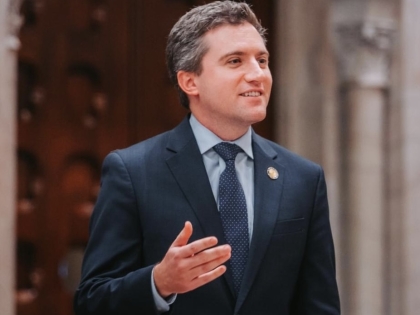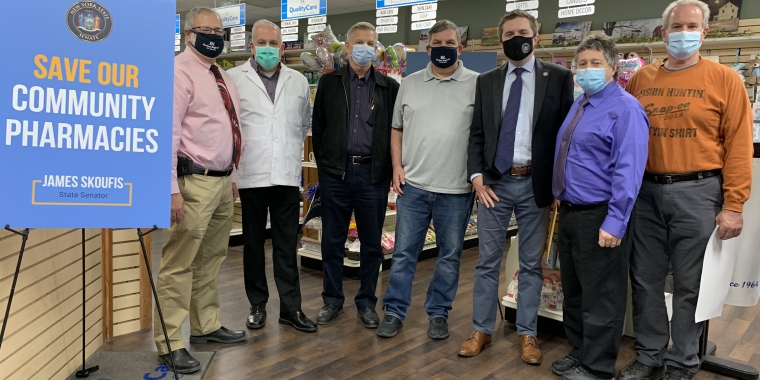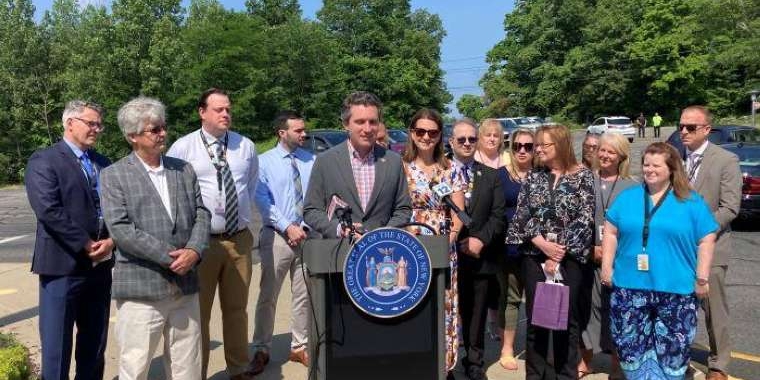
Mom-and-Pop Pharmacies Struggle to Hang On

Senator James Skoufis gathers with local pharmacists at NeighboRx in Slate Hill, NY.
Mom-and-pop pharmacies across the Hudson Valley and beyond say they are hanging on as best they can while navigating not just the pandemic, but another threat they see to their future: pharmacy benefit managers, which pharmacist Dr. Neal Smoller of Woodstock’s Village Apothecary describes as the “the biggest threat to quality care in communities.”
Pharmacy benefit managers, or PBMs, are third-party companies that manage prescription drug benefits on behalf of health insurers and, ultimately, millions of Americans. The intended role of PBMs — who sit at the center of health insurers, drug manufacturers and pharmacies — is to advocate for lower drug costs for health plans and the consumers who use them, and to determine which drugs will be covered by plans. They are a critical player in the payment chain for prescriptions medications.
The industry is fairly concentrated, with three of the largest PBMs in the U.S. — CVS Caremark, Express Scripts, and OptumRX — collectively handling about 75 percent of all prescription claims in this country.
The big issue, small pharmacies and critics say, is the power PBMs have over the pharmaceutical industry and market, and a lack of transparency regarding drug pricing. PBMs require pharmacies to pay upfront for the scripts that they fill. Pharmacies then have to wait for prescription benefit reimbursements, which can be a hard financial burden for independent pharmacies to bear and sometimes isn’t reimbursed at the full amount. Health insurance company Anthem sued Express Scripts five years ago, saying it was overpaying for pharmaceuticals, and local pharmacies in the Hudson Valley say they, too, feel like they are overpaying.
New York state senators James Skoufis and Mike Martucci are introducing measures to protect independent pharmacies, timing that is especially important with only a few remaining weeks left in the legislative session in Albany.
In January 2019, Skoufis launched an investigation into the PBM industry, calling for policy changes for better transparency. In a statement justifying the investigation, Skoufis claimed that PBMs generate revenue through spread pricing, whereby PBMs charge health plans more for generic drugs than the PBMs actually pay the pharmacies for those medications, in turn keeping that pricing spread as a profit. Skoufis has said that a lack of oversight of PBMs allows pricing practices that come at “the detriment of consumers.”
That 2019 bill was vetoed by Gov Andrew M. Cuomo – which Skoufis called “beyond disappointing” in a statement at the time.
“Taking on the pharmaceutical industry is an uphill battle, but I won’t stop until we get this right,” Skoufis said in a recent press release on May 7. “When there’s a family facing a health crisis, it’s not CVS or PBM companies that are out delivering medications or opening the shop after hours to lend a hand.”
The current legislative package, proposed by New York State Sen. Neil Breslin, would “level the playing field and allow our local pharmacies to fairly compete in the marketplace,” said Martucci in the same May 7 press release. The proposed bill would provide an appeals process to investigate disputes regarding multi-source generic drug pricing in a push for transparency. Additionally, the bill would require PBMs to disclose to the plans with whom they contract any other possible revenue streams.
Spokesman Phil Blando of CVS Health, which has vaccinated thousands of New Yorkers in the pandemic and delivers medications to consumers just as independent pharmacies do, cautions that the proposed legislation would increase prescription costs and result in higher premiums for employers. “CVS Health urges legislators to stand with New York families and reject these harmful proposals,” Blando said in a statement to Times Union: Hudson Valley.
Smoller, meanwhile, isn’t optimistic that the drug pricing system will change.
“There is no solution,” said Smoller, who hosts his own pharmacy-related Hudson Valley-based podcast and was the owner of former Village Apothecary in Saugerties. He decided to sell that pharmacy five years ago when he said his margins were too tight to continue because of a steady pattern of partial reimbursements from PBMs that made it difficult to remain financially competitive.
At Village Apothecary, he has a large focus on vitamins and wellness rather than just prescriptions — “the only reason that business can stay open.”
“If all of the consumers realized how bad this was and spoke up loudly and clearly say, ‘Pharmacists are valuable, lower the costs of drugs, and pay our providers,’ that’s what would change it,” said Smoller. “We need legislators to [take] the money interest out and put consumers first.”
A three-fold issue
Dr. Jared Nekos of New Paltz’s Dedrick’s Pharmacy, which has been in business for over 50 years, said the issues are three-fold and relate to: reimbursement for prescriptions, fees from Medicare called direct and indirect remuneration (DIR fees), and mandatory mail-in orders.
Insurance companies “keep slashing our reimbursements,” said Nekos. “A third of my scripts, I lose money on. If I do a three-month supply of a diabetes medication, I’m almost guaranteed to lose somewhere between $20 and $150.”
At Village Apothecary, during the pandemic “dozens of dozens of people transferred to the pharmacy daily,” said Smoller, which actually accelerated the pharmacy’s losses for the year.
“A lot of them were patients where the total reimbursement [from insurance providers] for the patient was negative,” said Smoller. “If someone transfers four prescriptions to us, we lose $80 total because the reimbursement that the insurance sets is below our costs.”
Because there are a number of variables when it comes to costs, like insurance plans, benefits and providers, it isn’t always uniform between what the true drug cost is, what the markup is, and what amount the pharmacy would get reimbursed. The drug could cost anywhere between hundreds or thousands of dollars, which might only be partially reimbursed, and then the pharmacy could also be hit with a DIR fee months later.
DIR fees are essentially the funds that Medicare may collect to offset member costs. Nekos said that at his pharmacy, the plans are taxed between three and five percent of the sale price, in a market that already has “razor thin margins.” He said DIR fees can amount to tens of thousands of dollars each year depending on volume, essentially erasing some pharmacies’ profits.
Yet another challenge that independent pharmacies face is mandatory mail orders. “Most people don’t have flexibility in their healthcare – if you’re a teacher, you use the teacher’s union [health plan]. If you work for Bank of America, whatever Bank of America offers is what you get,” said Nekos.
In Dutchess County, for example, the Dutchess Educational Health Insurance Consortium provides healthcare for participating school districts, and the plan includes a mandatory mail order. That order means some customers would have to change how they receive their prescriptions and who fills them.
In other words, a customer who had been going to Dedrick’s Pharmacy for years would then be told that now all of their prescriptions will be mailed to them instead.
“I can’t think of anything more un-American or unfair than saying you can’t choose who to patronize, where to get healthcare and where to spend your hard-earned money,” said Nekos.
How small pharmacies weathered the pandemic
Since the start of the pandemic, Smoller said the workload at his pharmacy, like any other, has increased “tremendously,” due to the implementation of curbside and delivery pickup, which requires more help per transaction from each employee. While prescription volume was initially down at the start of the pandemic, it “normalized pretty quickly.”
Throughout the pandemic, and especially more recently, local pharmacies have also stepped up their services to meet growing need for information and vaccinations. Village Apothecary is responsible for 23 percent of the COVID-19 vaccine doses administered in Ulster County. In Dutchess County, Village Apothecary has administered 6,000 doses. To date, Village Apothecary has vaccinated around a total of 38,000 people across the two counties, for which they get varying reimbursements, depending on the person’s insurance plan.
Aside from the vaccination roll-out, all year long Smoller has also been disseminating information online and via digital webinars about the risks of transmitting the virus, in an effort to support his community customer base. If he had sold Village Apothecary as he had the Saugerties pharmacy, he would not have been able to provide such public health benefits, he said.
What’s next?
For now, Smoller said he will keep reinventing his pharmacy and educating his customers to support legislative change while fearing the possibility that independent pharmacies may die out. “A pharmacy is pandemic-proof and recession-proof, but we are constantly under attack,” said Smoller. “We’re at a point where it’s make or break in New York.”
In Nekos’ opinion, the reason PBMs keep making things harder for independent pharmacies is because they know mom-and-pop pharmacies can offer something that they aren’t able to. “When you go to other independent pharmacies, the level of service and care you get is second to none … it’s a completely different experience and it should be the norm when dealing with health,” said Nekos.
The fight for mom-and-pop pharmacies doesn’t end with PBM requirements. There is other legislation on the table in New York for this session, introduced by Skoufis, that adjusts mail-order prescription requirements, calls for the ending of unjustifiable drug price markups, and the protection of patient access to essential pharmacy care and services.
“The key here is it has to be actionable legislation and a difference maker,” said Nekos. “There is a need for politicians, legislators and lawmakers to talk to the real people. If they’re going to act, make a difference.”

